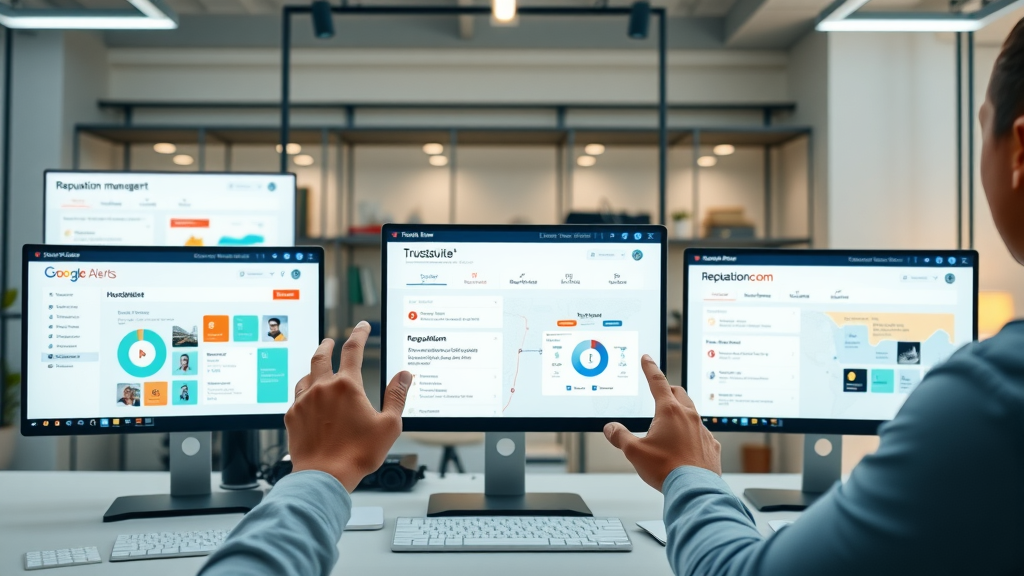Boost Online Reputation Today: Secrets Pros Use

Did you know that 97% of consumers search online before choosing a local business? Your digital reputation is a silent but powerful factor in your overall business success. In this comprehensive guide, you’ll discover the proven strategies top professionals use to boost online reputation and turn every customer interaction into an opportunity. If you’re ready to grow trust, attract new clients, and safeguard your brand, you’re in the right place!
- The urgent reasons to boost your online reputation now
- Key steps and pro tips for online reputation management
- How to recover from negative reviews and build trust
- Essential tools and resources for active management
- Actionable advice for individuals and businesses alike
Startling Statistics Reveal the Urgency to Boost Online Reputation
Your online presence is more critical than ever as consumers increasingly rely on digital research before making decisions. The following startling statistics make it clear why you need to focus on online reputation management now:
- 97% of consumers search online for local businesses.
- 85% trust online reviews as much as personal recommendations.
- Negative online reputation can deter over 60% of potential customers.
Statistics like these highlight the immense influence of online reviews and digital comments. With nearly everyone searching online, even a few negative mentions can dramatically impact your business success. Customers now equate your online reputation with your actual reputation.

“Your online reputation is your business reputation.” — Industry Expert
Why Prioritizing Online Reputation Management Is Critical
The necessity to boost online reputation goes beyond mere public image. It is now a vital part of sustaining business growth, building trust, and competing in a digital-first world. When you put your online reputation management at the forefront, you shape perceptions, attract new clients, and create opportunities that may otherwise pass you by. Let’s dig into why this is more important than ever—and how to start proactively managing your brand’s digital footprint.
Businesses and individuals who ignore their online reviews risk losing over half of their potential customers to competitors with a more positive online presence. Furthermore, an active approach to reputation management is now a necessary investment in marketing and long-term success. By making reputation a priority, you’re not just reacting to problems—you’re building a resilient trust platform for the future.
Understanding the Impact of Online Reputation on Success
- Influence on customer trust and loyalty
- Role in digital marketing strategy
- Signals used by search engines in ranking algorithms
The impact of your online reputation can be measured in real business outcomes. Consumers are far more likely to trust and remain loyal to brands that appear positively in online reviews and maintain open, authentic engagement. Search engines use reputation signals—like review scores, response rates, and content quality—to help determine rankings. A positive reputation doesn’t just build trust, but also improves visibility in search engine results, reinforcing your digital marketing strategy.
Additionally, consistent positive reviews are powerful trust-building assets. They act as endorsements, encouraging prospects to choose you over less reputable competitors. Ultimately, your reputation becomes a key factor in the entire customer journey—from the first online search to the final purchase decision.
Connecting Online Presence, Social Media, and Reputation Management
- The synergy between social media platforms and online reputation management
- Establishing authority through consistent online presence
- Relationship between positive online reviews and credibility
Effective online reputation management isn’t limited to responding to reviews. It requires integrating social media , website content, and proactive customer communication. Social media platforms act as both amplifiers and monitors for your online reputation—what people say and share can quickly influence customer perception.
Consistent online presence across multiple platforms also strengthens your authority. By maintaining unified branding, tone, and values across all digital touchpoints, you signal reliability to both customers and search engines. Positive online reviews shared on social media drive credibility and reach even further, creating a cycle of trust and ongoing success.

Essential Steps to Boost Online Reputation Effectively
Ready to actively boost online reputation ? The good news is that you don’t need to be a tech wizard or marketing genius to see improvements. Consistent, thoughtful actions—guided by proven strategies—will help safeguard your digital presence and drive business growth. Below are the steps professionals use for effective online reputation management:
Audit and Monitor Your Online Presence
- Setting up online monitoring alerts
- Evaluating your profiles across media platforms and review sites
- Analyzing search engine results
The first stage in managing your online reputation is to conduct a thorough audit. Start by searching your business and personal name on major search engines to see what appears in the results. Set up Google Alerts for your brand, product, and key personnel to receive real-time notifications about new mentions or online reviews . Evaluate your presence and activity level across all social media platforms , industry review sites, and directories.
Regular monitoring ensures you catch negative feedback or misinformation before it spreads. Analyze the results monthly and pay attention to recurring trends. By actively managing and updating your profiles and reacting promptly to reviews, you strengthen customer trust and reduce reputational risk.
Manage and Respond to Online Reviews
- Responding to both negative and positive reviews
- Strategies for addressing negative review situations
- Encouraging satisfied customers to leave a review
Proactive engagement with online review platforms is one of the most effective ways to build trust and credibility. Always thank customers for their feedback—whether positive or negative. When responding to a negative review , keep your tone calm and professional, acknowledge the customer’s experience, and offer a resolution if appropriate.
Don’t forget to show appreciation for positive reviewers as well. A gracious response not only encourages repeat business, but also signals to future customers that you genuinely care about customer satisfaction . Encourage satisfied customers to leave their feedback with strategic follow-up emails or in-person requests immediately after a great experience.

Optimize Social Media Presence for Online Reputation
- Selecting the best social media platforms for your brand
- Crafting consistent messaging
- Leveraging social media for proactive reputation management
Not all social media platforms will be relevant for every business. Choose platforms where your audience is most active, whether it’s Facebook, LinkedIn, Instagram, or Twitter. Craft a clear, consistent message that speaks to your values and value proposition. Use the same logo, colors, and tone across accounts to reinforce your brand identity and trustworthiness.
Actively engage with followers by responding to comments, sharing valuable content, and participating in discussions. Proactively share positive testimonials or customer stories to shape public perception. A vibrant and unified social media presence will not only boost online reputation but also increase organic reach and drive referrals.
Utilize Review Sites to Build Trust and Credibility
- List of key review sites by industry
- Techniques for increasing positive reviews and handling negative reviews
- Google Business and Google My Business optimization tips
Industry-specific review sites are goldmines for establishing trust. For example, restaurants rely on Yelp and TripAdvisor, while professionals may focus on Google My Business and LinkedIn endorsements. Develop a process for asking all satisfied customers to leave a review and send them direct links to your profiles for ease.
When negative reviews arise, respond professionally and never take criticism personally. Remember, even negative comments can be turned into opportunities if addressed publicly and constructively. Regularly update your Google Business and Google My Business listings with accurate hours, photos, and descriptions to reflect the quality and reliability of your brand.

Leverage Positive Online Content Creation
- Publishing quality content to outrank negative results
- Using customer experience stories to generate positive reviews
- Media presence and public relations strategies
Content is the anchor of a strong online reputation . By publishing high-quality, keyword-rich blog posts, customer success stories, and helpful resources, you suppress negative search engine results and enhance positive online mentions. Use real customer experience narratives to humanize your brand and showcase your commitment to satisfaction.
Amplify this content through media presence and proactive public relations—press releases, local features, and guest posts increase your authority and drive more positive coverage. The more useful, authentic, and engaging your content, the stronger your digital reputation becomes over time.
Pro Tips from Leading Online Reputation Professionals
- Employ reputation management tools
- Foster ongoing engagement on social media and review sites
- Embrace transparency and authenticity
- Establish a crisis plan for online reputation emergencies
Experts in reputation management use automated tools to monitor brand mentions and streamline social engagement. Tools like Google Alerts, Hootsuite, and Trustpilot help consolidate feedback and track analytics across platforms. Foster ongoing engagement by responding swiftly to reviews, sharing fresh content, and communicating transparently in all interactions—even during a crisis.
If a crisis or negative feedback occurs, follow a predetermined plan: acknowledge the issue, communicate your response publicly, and clarify resolution steps. This approach not only protects your brand from damage, but can also transform a negative review into a demonstration of accountability.


Common Mistakes That Hurt Your Online Reputation
- Ignoring negative reviews or responding defensively
- Inconsistent branding across online presence
- Neglecting reputation management on relevant media platforms
- Overlooking the role of public relations
The most damaging mistakes occur when businesses ignore criticism, respond emotionally to reviews, or allow inconsistencies across digital profiles. Defensive or absent responses to a negative review can escalate issues and deter potential customers. Likewise, a scattershot approach to branding makes it hard for customers to trust your organization.
Neglecting to manage your reputation on important platforms—whether it’s Yelp, industry-specific sites, or even Google My Business —puts you at a disadvantage. Public relations and transparent communication are essential to navigating tough situations and ensuring your positive story is always front and center.
How to Address Negative Reviews and Build a Positive Online Reputation
Treat every negative review as an opportunity to demonstrate customer-centric values and transparency. By providing a public, respectful response, you showcase professionalism and a genuine desire to improve.
Transforming a Negative Review into an Opportunity
- Steps to resolve legitimate customer complaints
- Benefits of public, professional responses
Start by acknowledging the customer’s perspective and apologizing for any inconvenience, even before investigating the details. Offer concrete steps for resolution, such as refunds, replacements, or corrective action. Take the resolution offline if needed—but always confirm the outcome publicly. This approach demonstrates accountability, boosts trust, and signals to future clients that you value all feedback—good or bad.

Encouraging Satisfied Customers to Leave Positive Review
- Methods to motivate customers to leave a review
- Timing and follow-up best practices
The most effective way to increase positive reviews is to ask directly, at the right moment—ideally immediately after a successful transaction or customer support experience. Use digital receipts, follow-up emails, or in-person requests to remind satisfied customers to leave a review . Provide easy-to-follow links and instructions for maximum participation.
Make it a routine part of your process, and consider incentives (where permitted), such as discounts or loyalty points. Timely follow-up ensures the positive customer experience is still fresh, increasing the likelihood of authentic, glowing feedback.

Building and Sustaining Your Online Presence Across Platforms
Sustaining a strong online presence means remaining active and engaged on all major digital channels. By scheduling consistent updates, monitoring engagement, and customizing your approach for different audiences, you ensure long-term reputation management success.
Consistency in Social Media and Media Presence
- Scheduling regular posts on social media platforms
- Monitoring brand mentions and engagement rates
Consistency is crucial to gaining traction on social media . Develop an editorial calendar to plan regular posts tailored to each platform, keeping your brand at the forefront of your audience’s mind. Use analytics tools to monitor mentions, track interaction rates, and adjust your strategy as trends emerge.
Frequent, relevant content and prompt responses to comments or questions cement your authority and instill confidence among your audience. A predictable, well-managed media presence reinforces your brand and increases visibility across channels.
Reputation Management for Businesses and Individuals
- Customizing strategies for professionals and companies
- Integrating reputation management into daily routines
Every organization and individual has unique needs when it comes to reputation management . Businesses should establish internal guidelines for handling reviews and feedback, while individuals may focus on optimizing personal profiles and networking within their industry. Whichever your focus, integrating reputation management tasks into daily or weekly routines—such as checking review sites every Friday or posting to social media accounts every Monday—safeguards your online identity and builds long-term trust.

Best Tools and Resources to Boost Online Reputation
Effective reputation management starts with the right set of tools. These industry-favorite platforms streamline monitoring, engagement, and response—making it easier for you to stay ahead of the curve and manage your brand proactively:
| Tool Name | Functionality | Best Use Case |
|---|---|---|
| Google Alerts | Brand monitoring | Real-time notifications for mentions |
| Hootsuite | Social media management | Posting & tracking engagement |
| Trustpilot | Review site | Collecting & showcasing online reviews |
| Reputation.com | All-in-one management | Comprehensive reputation management |

Experts Weigh In on Online Reputation and Social Media Success
“A single negative review can be a learning opportunity and even strengthen customer loyalty if managed correctly.” — Reputation Management Leader
Industry leaders agree: transparency, communication, and ongoing investment in online reputation management set the foundation for digital success. Turning potential pitfalls into showcases for your values is what separates thriving brands from those left behind.
How to Fix Your Online Reputation Efficiently (People Also Ask)
How to fix your online reputation?
- Identify and assess negative reviews and online mentions
- Develop a response and outreach plan
- Request removal of defamatory content when possible
- Build new positive online content and secure fresh positive reviews
Fixing your online reputation starts with a thorough assessment of all existing content and mentions. Develop a strategy to address negative items—respond to legitimate complaints, and politely request removal of baseless or defamatory comments when possible. Then, create and share new, positive content to push down negative results and actively seek positive reviews from your best customers.
How do I improve my website reputation?
- Ensure website is user-friendly, updated, and secure
- Add testimonials and online reviews
- Optimize for search engines and implement structured data
Start by making your website fast, mobile-friendly, and secure (using HTTPS). Feature testimonials and online reviews prominently, and regularly update your content to enhance value and boost rankings. Implement SEO best practices, like incorporating keywords, adding schema markup, and optimizing meta tags to reinforce organic search performance and trust.
How to build a positive online reputation?
- Engage authentically on social media and review sites
- Consistently create value-driven content
- Encourage regular positive feedback from customers
Focus on genuine engagement—respond to questions, join conversations, and be a visible presence in relevant communities. Share consistent, helpful content and encourage satisfied customers to vouch for your brand on review sites and social media . Building a positive reputation is an ongoing process that compounds with every interaction.
How do I clean up my online reputation?
- Remove inaccurate or outdated information where possible
- Suppress negative results through proactive content
- Request edits on review sites and correct factual errors
Begin by claiming and updating all your business and social profiles. Where possible, remove or request edits to outdated or incorrect information. If you find misleading or negative content, respond appropriately, and produce new high-quality content to shift public perception. Regular maintenance is key to a clean, positive online presence .

Comprehensive FAQs on How to Boost Online Reputation
- What is the first step to boost online reputation fast? Begin with a full audit—search your brand, set up alerts, and identify any negative or outdated information. This gives you a clear understanding of your current position and top priorities.
- How long does it take to rebuild online reputation after a negative event? Recovery time varies, but you can often see noticeable improvement in three to six months with active management, prompt responses, and fresh positive content.
- Can fake reviews be removed from review sites? Many sites allow you to report and request the removal of fake or malicious reviews. Provide evidence to support your claim, and follow up for resolution.
- How frequently should online reputation management be performed? Regular monitoring is essential—check for mentions at least weekly, and respond to online reviews as soon as possible to maximize impact.
- What is the impact of social media platforms on online reputation? Social media acts as both a megaphone and monitoring tool, amplifying brand messages and providing real-time feedback that shapes overall perception.
Action Steps: Begin Elevating Your Online Reputation Management
- Start with an online reputation audit
- Update and secure all online presence profiles
- Proactively seek and showcase positive online reviews
- Engage authentically on all major social media platforms
- Develop a reputation management action plan
Take these steps now to move from passive observer to active reputation champion. By maintaining vigilance and implementing best practices, you’ll consistently boost online reputation and enjoy the trust you deserve.
Key Takeaways to Boost Online Reputation Like a Pro
- Strong online reputation drives business growth and trust
- Reputation management is ongoing and cross-channel
- Every interaction and review shapes your online future
Transform Your Online Reputation Today
“Don’t let your reputation be an afterthought — take action and boost your online reputation!”
Further Reading and Related Resources
- Top books on online reputation management
- Latest research on online presence strategies
- Industry-leading blogs for reputation tips
Ready to Boost Your Online Reputation? Take Strategic Action Now
- Assess your current position
- Identify improvement areas
- Implement expert-endorsed techniques for reputation management
- Reach out to professional services if needed
Start today: Audit your digital footprint, engage with every review, and make online reputation management a regular business habit.
To further enhance your understanding of online reputation management, consider exploring the following resources:
-
“7 Tactics for Monitoring Your Online Reputation” : This article provides practical strategies for keeping track of your brand’s online presence, including tips on managing reviews and auditing your website. ( bbb.org )
-
“Building Trust with an Online Reputation Strategy” : This resource outlines essential steps for monitoring and improving your online reputation, emphasizing the importance of engaging with your audience and maintaining accurate online profiles. ( web.com )
By delving into these articles, you’ll gain valuable insights into effective reputation management practices that can help you build trust and attract new clients.





